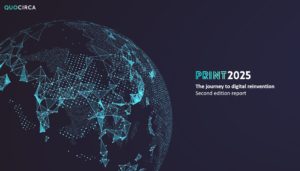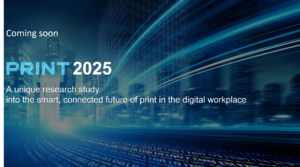
Print renaissance: The value of print in the age of distraction
September 26, 2017
Article, Channel, Digital Transformation, Trends
Far from being dead, print is enjoying a resurgence as a way for people to disconnect from the noisy online world. As a trusted and tangible medium, the printed page provides longevity and an emotional connection that cannot be replicated by a screen. Print has the potential to disrupt digital media channels, rather than be disrupted by them. So why has print endured, and how can it be made relevant for today’s digital world?
The return to traditional media
Since the invention of the Gutenberg printing press in 1440, the printed word has stood the test of time. It has endured as a communications medium through the evolution of newspapers, radio, TV, mobile, the web and social media. When a new form of communication arrives, the new does not necessarily replace the old; television was expected to sound the death knell for radio, CDs were supposedly a replacement for vinyl, and the internet and email were forecast to kill print. None of these things have transpired.
Although print is undeniably diminishing in some areas – such as newspaper publishing and print advertising – people’s need for the tangible is leading to a revival in traditional media. Vinyl is making a comeback and sales of printed books are on the rise. According to the Publishers Association, eBook sales plunged by 17% in the UK in 2016, while physical book sales rose by 8%. The picture is similar in the US where eBook sales declined by 1.7% in 2016 with paper book sales up by 7.5%.
And while online may be the channel of choice for the millennial generation (born in the 1980s and 90s), they also value print media. It is reported that 77% of Millennials pay attention to direct mail advertising and nearly half made a purchase because of something they read about in a magazine 1.
Meanwhile Millennials are also rediscovering physical photographs, contributing to the success of instant photo printers such as the HP Sprocket and Polaroid Zip which allow photos to be printed directly from a smartphone.
Another traditional media, direct mail, is also seeing a resurgence as a means to stand out from the daily bombardment of online messages. While our inboxes are overflowing, our letterboxes are relatively empty. We are more likely to pay attention to a well-designed piece of mail: according to research from the Direct Marketing Association (DMA) 79% of consumers will act on direct physical mail right away, while only 45% will take immediate action after receiving an email.
So why does print still matter in the digital age?
Our affinity for the printed page
While digital communication offers immediacy and efficiency, it has its limits. Digital simply cannot match the unique characteristics of ink on paper.
- Tangibility. A printed page engages more senses (not just sight, but touch and even smell) than an online advertisement or email, and carries a sense of prestige with qualities that can’t be replicated on screen. Distinctive features such as unique colours, foiling and textures can deliver a more engaging and immersive brand experience. Paper has a sense of permanence, until we decide to throw it away. In contrast, emails can be deleted with a click and online advertising is easily blocked.
- Trust. Readers often trust the printed page, and a high-quality piece of targeted and relevant print can have authority and convey importance. Print is less intrusive than online media, and in today’s climate of fake news it is often perceived as more credible.
- Retention. We are more engaged when we’re reading printed material, as it demands our full attention, and this helps us to avoid distractions from the ‘always-on’ digital world. Studies have shown that we absorb and remember more information when reading from paper than from a screen, when we often skim read. This ‘deep reading’ also creates deep thinking.
This time it’s personal
Amidst the online noise, there’s a real opportunity for print to grab the attention that digital channels are losing. The nature of high quality print means it stands out from digital messages and gains people’s undivided attention, helping to create an emotional connection that builds brand value and loyalty.
While digital cannot compete with the unique qualities of paper, print cannot work alone. Today the most powerful marketing campaigns are those that stretch across multiple platforms: websites, social media, email and print. Print must therefore be part of a multichannel approach that leverages customer data to deliver targeted, relevant and personalised communications.
Personalisation can bridge the gap between print and the online world, driving customers online or to bricks and mortar stores. Think personalised vouchers to spend online or instore, augmented reality apps such as Blippar, PURLS (personal URLs) or QR codes that direct you to a landing page. The market is diverse, and requires a combination of platforms ranging from variable data printing (VDP) to customer communications management (CCM) platforms that can segment and target customers.
Meanwhile, programmatic direct mail is emerging as a new opportunity for print – using analytics to trigger dynamic content for individual recipients based on online activity, for instance site or basket abandonment.
And print is not just for paper. Customised printed packaging on 3D objects, be it plastic, textiles or cartons, is about more than putting names on Coca Cola bottles or Nutella jars; it’s about developing brand recognition and marketing to wider audiences.
Print will continue to thrive
The more digital our lives become, the more we are looking for balance – and the more we’re rediscovering the tactile and tangible benefits of print. As such, print remains one of the most powerful and engaging channels available to brands. Its role in the digital world continues to evolve as digital channels fight for our attention. If it is used in a targeted, relevant way, and integrated as an on-ramp to online channels, print will remain an effective revenue-generating tool.
In this era of digital distraction, print is not dead. It’s not even close to extinction; in fact there has never been a greater opportunity for print to truly enjoy a creative renaissance.
To learn more about the future of print in the age of digital disruption please visit www.print2025.com
References
1 Millennials: An Emerging Consumer Powerhouse




